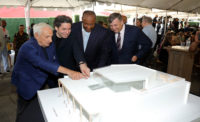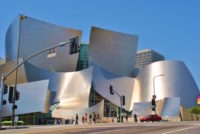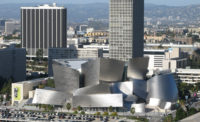Most symphonic halls are rarefied spaces, sequestered from urban street life. But in Inglewood, California, passersby along La Brea Avenue, a major thoroughfare, can look through the glazed facade of the Judith and Thomas L. Beckmen YOLA Center, across its shallow lobby and right into the 4,450-
square-foot performance hall, all the way down to the orchestral stage. And that is entirely by design. “We wanted the goings-on here—the process of creating beautiful music together—to be visible to people walking by, not mysterious or shrouded,” says Gustavo Dudamel, who oversees YOLA (Youth Orchestra of Los Angeles) as music and artistic director of its parent organization, the Los Angeles Philharmonic (LA Phil). “Cultural institutions must be vital parts of the communities they serve—it’s all about transparency and connection.”
Such outreach is at the core of El Sistema, the progressive music-education program founded in Venezuela in 1975, that inspired YOLA’s creation in 2007. Aspiring to empower social transformation through music, this widely emulated program offers free intensive orchestral training and instruments, with academic support and college or career guidance, to underserved youth. An immersive commitment, with after-school sessions five days a week, plus weekend activities, “it’s often about engaging the entire family,” says Dudamel, himself an El Sistema graduate who rose to lead its main orchestra (a title he still officially holds) in his native Venezuela before joining the LA Phil, in 2009, at age 28. “YOLA was a big factor in my decision to come to Los Angeles,” says the maestro. In the program’s 14 years of serving pupils from elementary through high school, it has grown from 80 to 1,300 students, and from a single site to four, within existing educational institutions across LA. Its orchestras have performed in top venues worldwide.
For YOLA’s flagship and first purpose-built location, the community of Inglewood, in southwestern Los Angeles County, was chosen in part for its significant low-income, minority population. (The city is also undergoing ambitious renewal, including a state-of-the-art sports-and-entertainment district, with its NFL stadium slated to host Super Bowl 2022 and its NBA Clippers Arena in the works.)
To house a new symphonic hall, a rundown onetime burger joint in a former bank building might not seem an obvious choice. But Frank Gehry—who’d created Walt Disney Concert Hall, the LA Phil’s main home, in 2003, and later offered his design services pro bono to YOLA—quickly saw the potential. The existing one-story pavilion had a column-free interior that he could open vertically by raising part of the flat roof and dropping the floor into an expanded basement level to achieve “that magic number of 45-feet high” for optimal acoustics. And he could give the stage the same dimensions as Disney Hall’s. “I wanted the best possible acoustics for these students,” he says, “and a hall that could attract members of the LA Phil and other professional orchestras to perform with YOLA and for the community.” The freestanding 1965 building, with its clean-edged modern lines, had further advantages, notably its central location, near public schools, Inglewood’s civic core, and transit lines.
Now sparklingly restored and transformed, the 25,895-square-foot building reopens in September. On its exterior, the $14.5 million project’s most significant change is a large, glassy cupola—the performance space’s added height—which becomes a glowing beacon by night.
By day, sunlight filters into the hall through its transparent back wall, clerestory windows,
and new skylight above its balcony and rear audience section—all openings with blackout screens and insulated acoustic glass. Also acoustical, the soaring 260-seat hall is an elongated hexagon. Designed for versatility, the space has raked, retractable theater seating and a double layer of space-dividing sliding panels that can create two acoustically isolated rehearsal venues, each holding a full orchestra.
With bare plywood and white-painted surfaces, the light-filled hall is a workspace. Its industrial-equipment and lighting grid is exposed overhead, and the balcony floor is polished concrete, with an underside of corrugated steel decking, visible from below.
The renovated interiors form a rectilinear “doughnut” configuration, with the central hall surrounded by three floors of circulation and support space, including practice, choir, and ensemble rooms, and backstage areas, plus a lobby, library, lounge, and kitchen (a particular convenience for the multigenerational family members often waiting hours in the wings). The doughnut’s role is also acoustical, buffering the hall from outside noise, including jets landing at nearby LAX airport. But, in contrast to the performance space’s acoustic purity, the passageways will hum with music spilling gently from practice rooms. Allowing such sounds to commingle is intentional, says LA Phil CEO Chad Smith. “It’s about the energy of the place and inspiring students through the experience of overhearing one another playing.”
During a recent rehearsal, the main space resonated with the rich tones of a Brandenburg Concerto, free of extraneous noise, as Nagata Acoustics International (NAI) put final touches on “tuning” the hall. Gehry had not only designed the center pro bono, but also gathered a team of top-notch longtime collaborators who donated their own services, including: NAI, under Yasuhisa Toyota’s leadership; Tillotson Design Associates (for lighting); and Meyer Sound. (TheatreDNA and Sonitus participated at steeply reduced rates.) Together, they achieved a work of great functionality and experiential qualities. “It was a labor of love for us all,” says Gehry. “We cried with joy when we heard the first notes played.”
Though this adaptive-reuse project may not have the boldly expressive, sculptural experimentation typically associated with Gehry’s work, it’s a thoughtfully designed building, airy, luminous, and welcoming. And, as Dudamel recently told his young orchestra, “This is yours—your place, your home, where you can play, speak your minds, and, from here, change the world!”









Post a comment to this article
Report Abusive Comment